St Mary’s Church, Tenby is located in the centre of the town, and is in the Diocese of Saint David’s. The site is believed to have been occupied by a church since Norman times, but most of the present building dates from the 13th century, with subsequent additions in the 14th and 15th centuries. The church contains several memorials, including the tomb of Thomas White, a former Mayor of Tenby who was famous for hiding Henry Tudor from King Richard III. There is a wall tablet in memory of Robert Recorde, an Elizabethan scholar, who introduced the equals sign to mathematics, and the Church also houses several memorials to military men from the Parish, as well as a memorial to the fallen of the Great War.
The Great War, 1914-1918
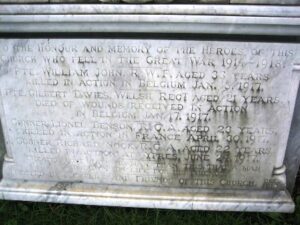
Lionel William Richard Benson, Gunner, 371219, Royal Garrison Artillery. Lionel was the Eldest son of William Walter Benson and Mary Anne Benson, of Gaspard House, Clarbeston Road, Tenby. He had enlisted at Milford Haven into the Royal Garrison Artillery, and been posted to their 68th Siege Battery in France. The Battery were armed with the 30 cwt 6” Howitzer, and they fought during the Gommecourt Offensive in July 1916. After spending the remainder of 1916 on the Somme, the Battery moved to Arras, which is where Lionel was wounded. Lionel died of wounds on 30 April 1917 aged 23, and is buried in Ste. Marie Cemetery, Le Havre.
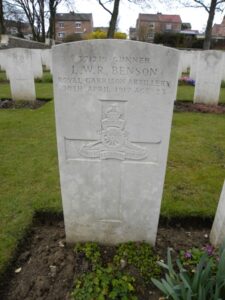
Foss Hunter Brown, Second Lieutenant, Royal Engineers. Foss was born at Gosforth, Newcastle-on-Tyne, the son of John Samuel and Elizabeth Annie Brown. The family later resided at 36, Victoria Street, Tenby. Foss received a commission into the Royal Engineers, and served with the 76th Field Company, Royal Engineers. The Field Companies were the technical men of the army at the time, and the 76th Field Company arrived in France attached to the 16th (Irish) Division. They moved to the Guards Division in August, 1915, and landed in France with them that month. The first action seen by the Guards Division was during the Battle of Loos. They then fought at Flers-Courcelette and Morval on the Somme, before following the German withdrawal to the Hindenburg Line in March 1917. The Division then moved to Ypres, and took part in the Battle of Pilckem, where Foss was Killed in action, on 31 July 1917, aged just 19. He is buried at Duhallow A.D.S. Cemetery, Belgium.
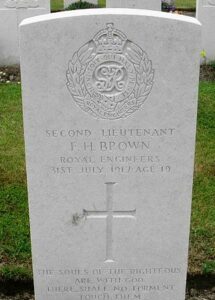
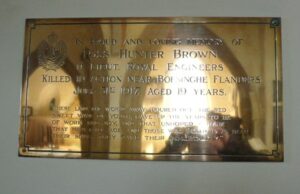
Gilbert Douglas Davies, Private, 56886, Welsh Regiment. Gilbert was the son of William Henry and Sarah Ann Davies, of Toronto Cottage, Clarbeston Road, Tenby. He enlisted at Carmarthen on 5 July 1915 into the Pembroke Yeomanry. On 4 August 1916 Gilbert landed in France, and was posted to the 13th Battalion, Welsh Regiment, which was attached to 114 Brigade, 38th (Welsh) Division, joining the battalion at Ypres, where it was rebuilding after the fighting at Mametz Wood. The 38th Division was by then in positions at the Canal Bank, north of Ypres, and it was here during his first winter on the Western Front that Gilbert was wounded on 15 January 1917. He was evacuated to the 46th Casualty Clearing Station at Mendinghem for treatment, but sadly died of wounds there on 17 January 1917, aged just 21. He is buried at Mendinghem Military Cemetery, Belgium.
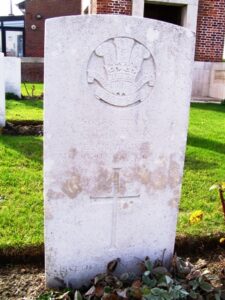
Henry May Henderson, MID, Lieutenant-Colonel, Royal Engineers. Henry was born on 31 December 1879, the son of Captain John Hannam Henderson, R.N., and Betsy Ann Henderson (nee May), of Red House, Tenby. He was the nephew of Admirals William, Sir Reginald and Frank Hannam Henderson. Henry obtained his commission in January 1899, and served with the 13th Field Company during the Boer War. He remained in the Royal Engineers after the Boer War, steadily making his way through the ranks, and was with the BEF in France when war broke out. He was wounded on 15 September 1914, during the Battle of the Aisne, and sent home to recuperate. On his recovery he was posted to the Royal Military Academy, Sandhurst as Chief Instructor in Military Engineering, and remained there until being sent to the front again in March 1916 as Major in charge of a Field Company, attached to the 18th Division. He was wounded again on 9 July, during the opening phase of the Somme Offensive, but remained in France, and was promoted Lieutenant Colonel in January 1917, and appointed Commanding R.E. of the 18th Division. Henry was also Mentioned in Despatches on 4 January. Sadly Henry was Killed in action on the Somme on 10 March 1917, aged 38. He is buried in Aveluy Communal Cemetery Extension, France. Henry is commemorated by a fine stained glass window inside the Church.
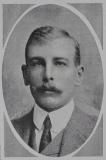
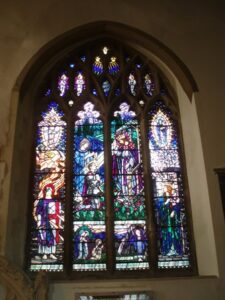
William John, Private, 55464, Royal Welsh Fusiliers. William was born at Tenby on 6 August 1883, the son of William John and Margaret John (nee Phillips), of Laugharne. He married Martha Elizabeth Davies in 1908, and the couple raised four children, at 29, Victoria Street, Tenby. William enlisted at Tenby into the Pembroke Yeomanry, but later transferred into the 16th Battalion, Royal Welsh Fusiliers, part of 113 Brigade, 38th (Welsh Division). The Division embarked at Folkestone on 5 December 1915, disembarking at Boulogne the same day. During the winter and spring of 1916 the Battalion held the line in the Armentières sector, and at the end of May, 1916 moved South with the remainder of the 38th (Welsh) Division to the Somme area, in readiness for the First Battle of The Somme. The 38th Division was tasked with the taking of the infamous Mametz Wood, with the first attack going in on 7 July, when the division lost heavily in ‘Death Valley’ during the advance on the ‘Hammer Head’. The next attack went in on 10 July and by 12 July the wood was cleared. Due to the terrible casualties taken by the Division during the capture of Mametz Wood, they were removed from the front, and posted to Ypres to rebuild. William was sadly killed in action during that first winter at Ypres, on 15 January 1917, aged 33. He is buried at Essex Farm Cemetery, Belgium.

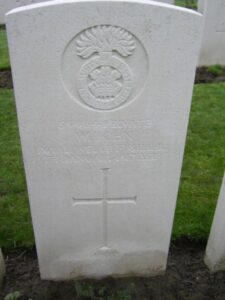
Francis John Dobree Knowling, MC, Captain, Argyll and Sutherland Highlanders. Francis was the younger son of Dr. Ernest Mansford and Helen Emily Hankey Knowling, of North Bay House, Tenby. He was educated at St. Andrews, Tenby and at Cheltenham College, and sat an Agricultural Course at Harper Adams College, Shropshire, which led to him being employed at Lord Rendlesham’s Estate in Suffolk. When war broke out, Francis enlisted in the Kings Shropshire Light Infantry, and on 22 September 1914 was commissioned into the Argyll and Sutherland Highlanders, and was posted to their 10th Battalion, attached to 27 Brigade, 9th (Scottish) Division. He moved to France with the Division in May 1915, and they fought at the Battle of Loos in September, where Francis was gazetted Captain, and was awarded the Military Cross for distinguished service in the field during June 1916. The Division were now at the Somme, and fought through most of the Somme Offensive, as well as the March 1917 Arras Offensive and at Third Ypres and the Battle of Cambrai. At sometime in 1917 Francis was wounded whilst serving on the Staff at Brigade Headquarters. After six months recuperating at home, he was passed fit for Home Service and was attached to an Officer Cadet Battalion at Crookham, Fleet as an Instructor but he must have become bored, and in January 1918 volunteered to return to his old Battalion at the front. Sadly Francis was soon killed in action, on 8 March 1918, aged 26. He is buried at Canada Farm Cemetery, Belgium.
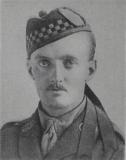
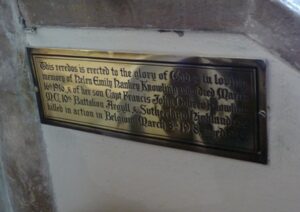
Richard Edwin Nock, Gunner, 371194, Royal Garrison Artillery. Richard was born in Newtown in 1895, the son of Richard Edwin nock and Maria Nock (nee Davies). By 1911 he was residing with his aunt and uncle, George and Elizabeth Davies, at Boston House, Tenby, where he was apprenticed to his uncle, who was a bootmaker. Richard enlisted at Hubberston Fort into the Pembrokeshire Battery, Royal Garrison Artillery. He was then posted to the 114th Siege Battery, Royal Garrison Artillery, which had been formed at Pembroke Dock on 8 March 1916 from members of the Pembrokeshire Royal Garrison Artillery. The Battery moved out to the Western front on 14 June 1916 equipped with four 6-inch Howitzers and initially joined the 32nd Heavy Artillery Group. By the time the Somme offensive opened on 1 July 1916 the 114th Siege Battery had been attached to the 28th HAG, joining the Fourth Army. The battery took part in the softening-up process during the Battle of Flers-Courcelette in September. The following year saw the 114th Siege Battery at Ypres, where it played a part in the Battle of Messines on 7 June 1917. Richard was killed by German counter-battery fire at Ypres on 24 June 1917, aged 22. He is buried at Belgian Battery Corner Cemetery, Belgium.
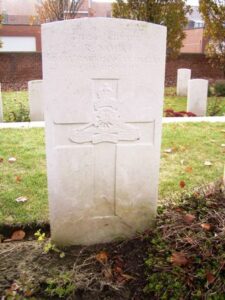
Henry Edwin Hunter Kent, Lieutenant, Rifle Brigade. Henry was the son of Captain Hunter Kent, R.N., and of Annie Kent. He was commissioned into the 22nd Battalion, Rifle Brigade, which was given the title ‘Wessex and Welsh’ Battalion, and was attached to 228 Brigade, 28th Division. The Division formed in England between December 1914 and January 1915 from regular units returning from India, Singapore and Egypt. During January 1915 it moved to France, landing at Le Havre and moved to the Western Front, where it saw its first major action during the Second Battle of Ypres. Following serious casualties at Ypres, a Composite Brigade was formed, composing of the 2nd Battalion, the Buffs, 2nd Battalion, the Cheshires, 1st Battalion, the Welsh, and 1st Battalion, the York and Lancaster. It was dissolved on 19 May 1915, and the formation assumed its normal configuration, taking part in the Battle of Loos. During October 1915, the Division embarked at Marseilles, and proceeded to Egypt, and in November moved on to Salonika where the Division then remained. The efforts of fighting the war in the malaria ridden countryside of Salonika proved too much for Henry though, and he died of its effects on 16 November 1922, aged 57. Henry is commemorated on a brass plaque sited within the Church.
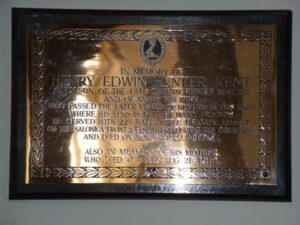
Other Military Memorials
There is a memorial book sited within the Church, which is kept in a glass case, which commemorates the men of the Parish who fell in the Great War of 1914-1918.
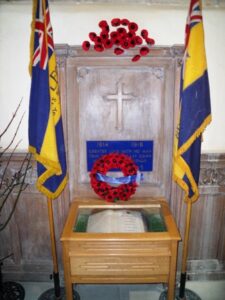
The Reid family are commemorated on an embossed copper plaque within the Church, which is in honour of the family’s long military history.
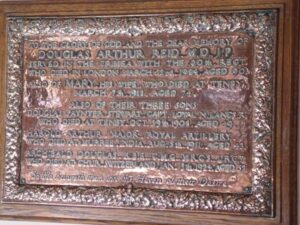
“To the Glory of God and the dear Memory of Douglass Arthur Reid, M.D., J.P. Served in the Crimea with the 90th Regt. Who died in London March 22nd, 1924, aged 90.
“Also of Mary, his Wife, who died at Tenby March 7th, 1912, aged 74.
Also of their three sons,
“Douglas Paynter Stewart, Capt. Loyal N. Lancs. R. Who died at Tenby, Oct. 29th, 1908, aged 49.
“Harold Arthur, Major, Royal Artillery. Who died at Murree, India, Aug. 5th, 1911, aged 43.
“Archibald Douglas, K.B.E., C.M.G., M.R.C.S., L.R.C.P. Who died at Chur, Switzerland, Jan. 5th, 1924, aged 52.
“So He bringeth them into the Haven of their Desire.”
A fine marble memorial on the wall of the Church commemorates Major Roger Lort, who was killed at Fontenoy in 1745. The Lorts were the Lord of Stackpole, and had taken an active role in the English Civil War. Roger Lort served as Major with the 23rd Regiment of Foot, the forerunner of the Royal Welsh Fusiliers. The memorial states that he met his death during the Battle of Fontenoy, near Lille, on 11 May 1745.
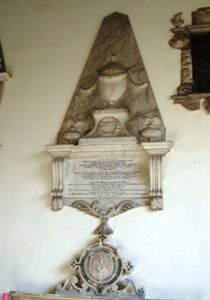
He was initially listed at the time as being missing, but had in fact been severely wounded and captured by the French on that date. He was evacuated to Lille but unfortunately died of his wounds at the Hospice Comtesse’s hôpital on 15 May 1745. He was buried the same day outside the city, as only Catholics were buried at that period in churchyards.
During the Battle of Fontenoy the 23rd Regiment lost 190 men dead, 87 wounded, and 47 missing. The white marble memorial has the following inscribed on it:
“To the Memory of Roger Lort Esq., youngest son of George Lort of Prickeston in this County, Esq., who, being Major of the regiment of Royal Welsh Fusiliers, was killed at the Battle of Fontenoy near Lisle A.D. 1745, aged 51 years.
“During a long residence in this Town, he discharged all the duties of a good Husband, Father, Master, Friend and Magistrate, and united in his character the various excellencies of the Soldier the Gentleman and the Christian.
“Also to the memory of Ann his Wife, only child of the Reverend Edward Jenkins, M.A.; Vicar of Fareham in Hants. A Pious, Prudent, Excellent Woman who died A.D. 1767, Aged 69. They had Six Children, Michael, Roger, Ann, George, Edward, John, of whom the only survivor in 1778, the Reverend Michael Lort B.D., Fellow of Trinity College in Cambridge erected this Monument.”